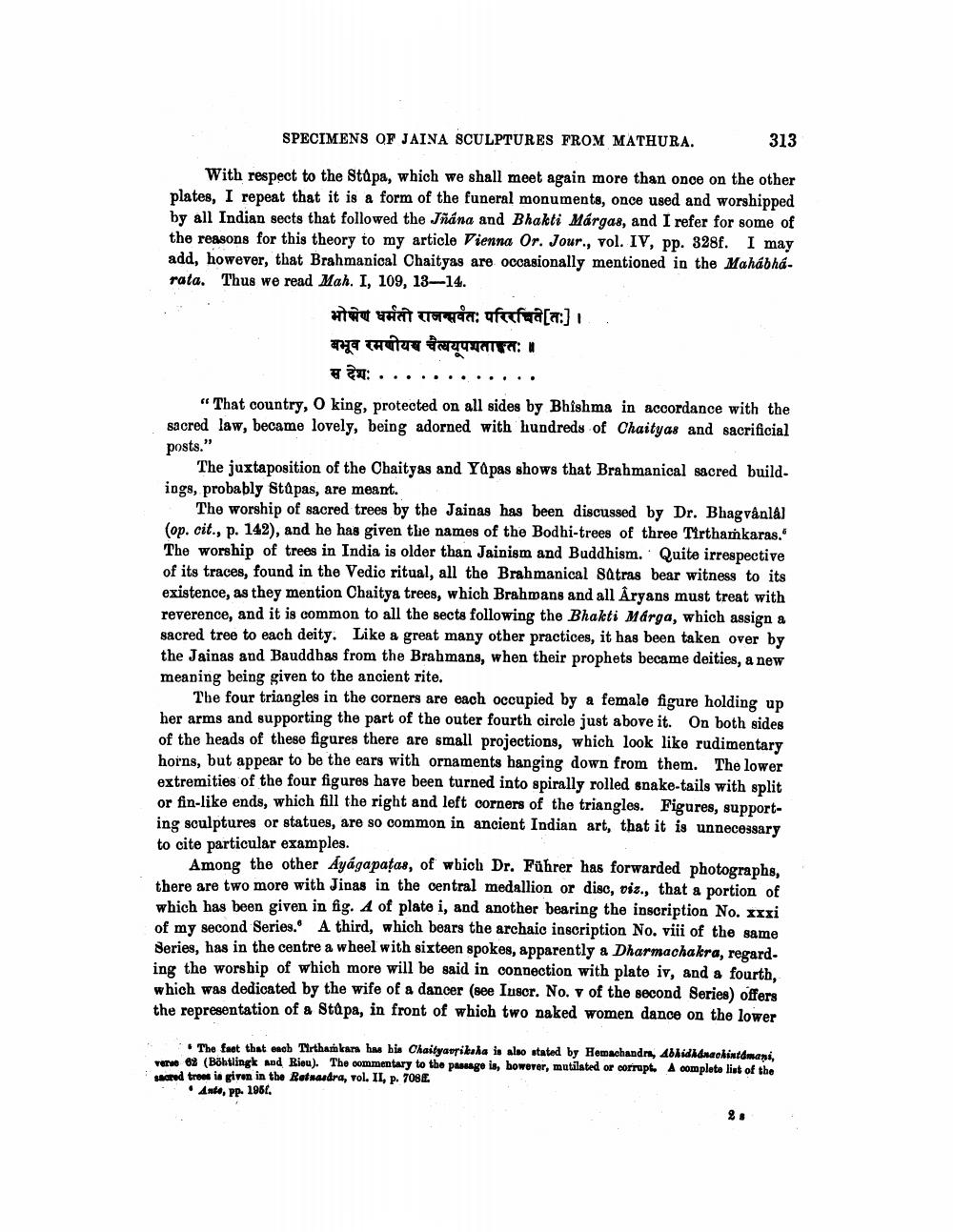________________
SPECIMENS OF JAINA SCULPTURES FROM MATHURA.
313
With respect to the Stapa, which we shall meet again more than once on the other plates, I repeat that it is a form of the funeral monuments, once used and worshipped by all Indian sects that followed the Jñana and Bhakti Margas, and I refer for some of the reasons for this theory to my article Vienna Or. Jour., vol. IV, pp. 328f. I may add, however, that Brahmanical Chaityas are occasionally mentioned in the Mahábhárata. Thus we read Mah. I, 109, 13-14.
भोभेण धर्मती राजन्मवत: परिरचिते[तः । . बभूव रमणीयच चैत्ययूपशताकृतः ।
............ "That country, O king, protected on all sides by Bhishma in accordance with the sacred law, became lovely, being adorned with hundreds of Chaityas and sacrificial
posts."
The juxtaposition of the Chaityas and Ydpas shows that Brahmanical sacred build. ings, probably Stapas, are meant.
The worship of sacred trees by the Jainas has been discussed by Dr. Bhagvanlal (op. cit., p. 142), and he has given the names of the Bodhi-trees of three Tirthamkaras. The worship of trees in India is older than Jainism and Buddhism. Quite irrespective of its traces, found in the Vedic ritual, all the Brahmanical Satras bear witness to its existence, as they mention Chaitya trees, which Brahmans and all Aryans must treat with reverence, and it is common to all the sects following the Bhakti Marga, which assign a sacred tree to each deity. Like a great many other practices, it has been taken over by the Jainas and Bauddhas from the Brahmans, when their prophets became deities, a new meaning being given to the ancient rite.
The four triangles in the corners are each occupied by a female figure holding up her arms and supporting the part of the outer fourth circle just above it. On both sides of the heads of these figures there are small projections, which look like rudimentary horns, but appear to be the ears with ornaments hanging down from them. The lower extremities of the four figures have been turned into spirally rolled snake-tails with split or fin-like ends, which fill the right and left corners of the triangles. Figures, supporting sculptures or statues, are so common in ancient Indian art, that it is unnecessary to cite particular examples.
Among the other Ayágapatas, of wbich Dr. Führer has forwarded photographs, there are two more with Jinas in the central medallion or disc, vis., that a portion of which has been given in fig. A of plate i, and another bearing the inscription No. xxxi of my second Series. A third, which bears the archaic inscription No. viii of the same Series, has in the centre a wheel with sixteen spokes, apparently a Dharmachakra, regard. ing the worship of which more will be said in connection with plate iv, and a fourth, which was dedicated by the wife of a dancer (see Tuscr. No. v of the second Series) offers the representation of a Stapa, in front of which two naked women dance on the lower
The fact that eneb Mrthamkan ha bia Chaityaoikaha is also stated by Hemachandn, Abhidldnachintamani, venne 88 (Böhtlingk and Rieu). The commentary to the passage is, however, mutilated or corrupt. A complete list of the sacred trees is given in the Ratnasara, vol. II, p. 708
Anth, PP. 1961.




